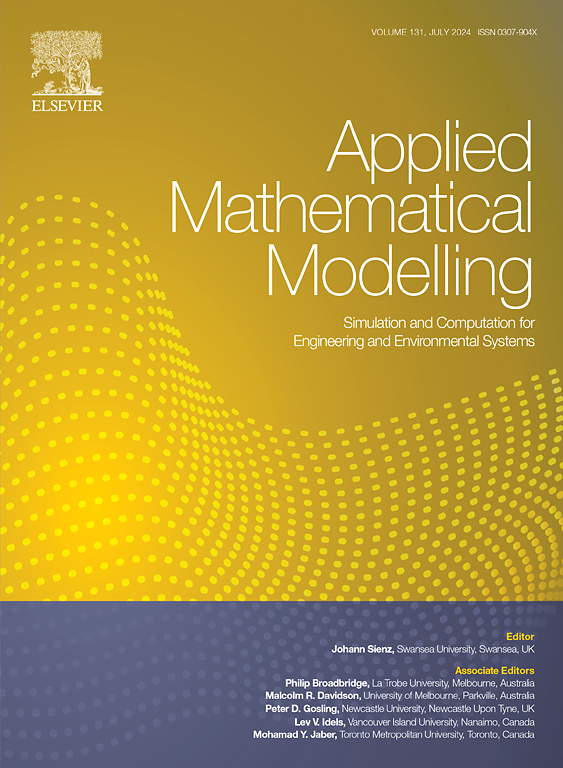Nonlinear static and dynamic buckling analysis of GPL-reinforced spherical caps and circular plates with porous core and stepped spiderweb stiffeners
IF 4.4
2区 工程技术
Q1 ENGINEERING, MULTIDISCIPLINARY
引用次数: 0
Abstract
This paper analyzes the nonlinear static and dynamic buckling responses of graphene platelet (GPL) reinforced shallow spherical caps and circular plates with porous core and stepped spiderweb stiffeners. The new design of stepped spiderweb stiffeners is proposed by adding meridian stiffeners near the edge region, and three regions are created as the edge region, the middle region, and the top region. Different GPL distribution laws, including U, X, O, A, and V laws are considered for GPL-reinforced face sheets, and the U, X, O, V, and A GPL distribution laws for spiderweb stiffeners are respectively chosen, while the trigonometric distribution law of porosity is designed for the porous core. The smeared stiffener technique is improved for stepped spiderweb stiffeners, combining with nonlinear Donnell shell theory, and nonlinear foundation model to derive the static and dynamic responses of the structures. The energy method is employed to perform the equilibrium equations for static problems, and the motion equation for dynamic problems. The static postbuckling responses are explicitly obtained, and the Runge-Kutta method is applied to investigate the nonlinear dynamic buckling behavior of the considered plates and shell caps. The numerical examples of nonlinear static and dynamic buckling of spherical caps and circular plates can predict the significant effects of spiderweb stiffeners, geometrical and material parameters, and nonlinear foundation. The results show that the spiderweb stiffeners largely enhance the buckling strength of spherical caps, while a higher porosity coefficient reduces mechanical but increases thermal postbuckling strength.
多孔核阶梯式蜘蛛网加筋gpl增强球帽和圆板的非线性静、动屈曲分析
本文分析了石墨烯平板(GPL)加固的浅球形帽和圆形板的非线性静态和动态屈曲响应,这些浅球形帽和圆形板带有多孔核心和阶梯蛛网加劲件。通过在边缘区域附近添加子午线加强筋,提出了阶梯蛛网加强筋的新设计,并创建了边缘区域、中间区域和顶部区域三个区域。对于 GPL 加固面片,考虑了不同的 GPL 分布规律,包括 U、X、O、A 和 V 规律,并分别选择了 U、X、O、V 和 A GPL 分布规律用于蛛网加强筋,同时为多孔芯设计了孔隙率三角分布规律。针对阶梯状蛛网加强筋改进了抹面式加强筋技术,并结合非线性 Donnell 壳理论和非线性地基模型得出了结构的静态和动态响应。采用能量法计算静态问题的平衡方程和动态问题的运动方程。明确获得了静态后屈曲响应,并应用 Runge-Kutta 方法研究了所考虑的板和壳盖的非线性动态屈曲行为。球形盖和圆形板的非线性静态和动态屈曲数值实例可以预测蛛网加劲件、几何参数、材料参数和非线性地基的重要影响。结果表明,蛛网加劲件在很大程度上增强了球形壳帽的屈曲强度,而较高的孔隙系数会降低机械屈曲后强度,但会增加热屈曲后强度。
本文章由计算机程序翻译,如有差异,请以英文原文为准。
求助全文
约1分钟内获得全文
求助全文
来源期刊

Applied Mathematical Modelling
数学-工程:综合
CiteScore
9.80
自引率
8.00%
发文量
508
审稿时长
43 days
期刊介绍:
Applied Mathematical Modelling focuses on research related to the mathematical modelling of engineering and environmental processes, manufacturing, and industrial systems. A significant emerging area of research activity involves multiphysics processes, and contributions in this area are particularly encouraged.
This influential publication covers a wide spectrum of subjects including heat transfer, fluid mechanics, CFD, and transport phenomena; solid mechanics and mechanics of metals; electromagnets and MHD; reliability modelling and system optimization; finite volume, finite element, and boundary element procedures; modelling of inventory, industrial, manufacturing and logistics systems for viable decision making; civil engineering systems and structures; mineral and energy resources; relevant software engineering issues associated with CAD and CAE; and materials and metallurgical engineering.
Applied Mathematical Modelling is primarily interested in papers developing increased insights into real-world problems through novel mathematical modelling, novel applications or a combination of these. Papers employing existing numerical techniques must demonstrate sufficient novelty in the solution of practical problems. Papers on fuzzy logic in decision-making or purely financial mathematics are normally not considered. Research on fractional differential equations, bifurcation, and numerical methods needs to include practical examples. Population dynamics must solve realistic scenarios. Papers in the area of logistics and business modelling should demonstrate meaningful managerial insight. Submissions with no real-world application will not be considered.
 求助内容:
求助内容: 应助结果提醒方式:
应助结果提醒方式:


